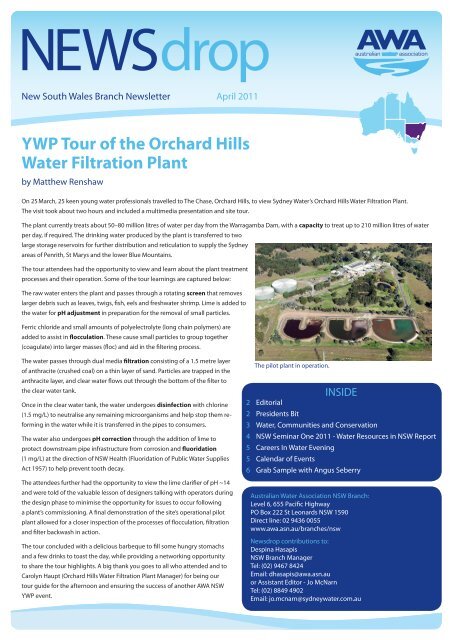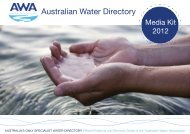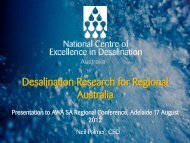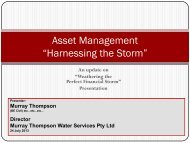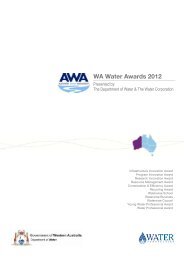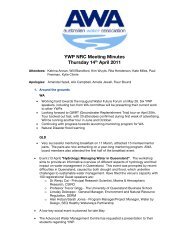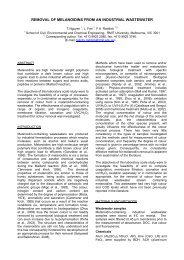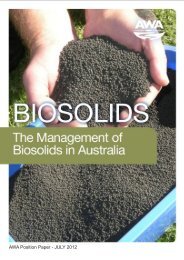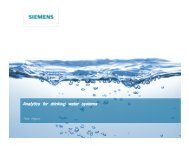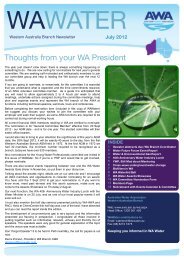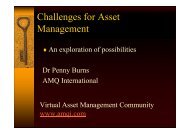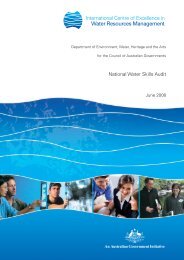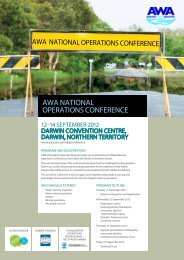YWP Tour of the Orchard Hills Water Filtration Plant - Australian ...
YWP Tour of the Orchard Hills Water Filtration Plant - Australian ...
YWP Tour of the Orchard Hills Water Filtration Plant - Australian ...
- No tags were found...
Create successful ePaper yourself
Turn your PDF publications into a flip-book with our unique Google optimized e-Paper software.
NEWSdropNew South Wales Branch Newsletter April 2011<strong>YWP</strong> <strong>Tour</strong> <strong>of</strong> <strong>the</strong> <strong>Orchard</strong> <strong>Hills</strong><strong>Water</strong> <strong>Filtration</strong> <strong>Plant</strong>by Mat<strong>the</strong>w RenshawOn 25 March, 25 keen young water pr<strong>of</strong>essionals travelled to The Chase, <strong>Orchard</strong> <strong>Hills</strong>, to view Sydney <strong>Water</strong>’s <strong>Orchard</strong> <strong>Hills</strong> <strong>Water</strong> <strong>Filtration</strong> <strong>Plant</strong>.The visit took about two hours and included a multimedia presentation and site tour.The plant currently treats about 50–80 million litres <strong>of</strong> water per day from <strong>the</strong> Warragamba Dam, with a capacity to treat up to 210 million litres <strong>of</strong> waterper day, if required. The drinking water produced by <strong>the</strong> plant is transferred to twolarge storage reservoirs for fur<strong>the</strong>r distribution and reticulation to supply <strong>the</strong> Sydneyareas <strong>of</strong> Penrith, St Marys and <strong>the</strong> lower Blue Mountains.The tour attendees had <strong>the</strong> opportunity to view and learn about <strong>the</strong> plant treatmentprocesses and <strong>the</strong>ir operation. Some <strong>of</strong> <strong>the</strong> tour learnings are captured below:The raw water enters <strong>the</strong> plant and passes through a rotating screen that removeslarger debris such as leaves, twigs, fish, eels and freshwater shrimp. Lime is added to<strong>the</strong> water for pH adjustment in preparation for <strong>the</strong> removal <strong>of</strong> small particles.Ferric chloride and small amounts <strong>of</strong> polyelectrolyte (long chain polymers) areadded to assist in flocculation. These cause small particles to group toge<strong>the</strong>r(coagulate) into larger masses (floc) and aid in <strong>the</strong> filtering process.The water passes through dual media filtration consisting <strong>of</strong> a 1.5 metre layer<strong>of</strong> anthracite (crushed coal) on a thin layer <strong>of</strong> sand. Particles are trapped in <strong>the</strong>anthracite layer, and clear water flows out through <strong>the</strong> bottom <strong>of</strong> <strong>the</strong> filter to<strong>the</strong> clear water tank.Once in <strong>the</strong> clear water tank, <strong>the</strong> water undergoes disinfection with chlorine(1.5 mg/L) to neutralise any remaining microorganisms and help stop <strong>the</strong>m reformingin <strong>the</strong> water while it is transferred in <strong>the</strong> pipes to consumers.The water also undergoes pH correction through <strong>the</strong> addition <strong>of</strong> lime toprotect downstream pipe infrastructure from corrosion and fluoridation(1 mg/L) at <strong>the</strong> direction <strong>of</strong> NSW Health (Fluoridation <strong>of</strong> Public <strong>Water</strong> SuppliesAct 1957) to help prevent tooth decay.The attendees fur<strong>the</strong>r had <strong>the</strong> opportunity to view <strong>the</strong> lime clarifier <strong>of</strong> pH ~14and were told <strong>of</strong> <strong>the</strong> valuable lesson <strong>of</strong> designers talking with operators during<strong>the</strong> design phase to minimise <strong>the</strong> opportunity for issues to occur followinga plant’s commissioning. A final demonstration <strong>of</strong> <strong>the</strong> site’s operational pilotplant allowed for a closer inspection <strong>of</strong> <strong>the</strong> processes <strong>of</strong> flocculation, filtrationand filter backwash in action.The tour concluded with a delicious barbeque to fill some hungry stomachsand a few drinks to toast <strong>the</strong> day, while providing a networking opportunityto share <strong>the</strong> tour highlights. A big thank you goes to all who attended and toCarolyn Haupt (<strong>Orchard</strong> <strong>Hills</strong> <strong>Water</strong> <strong>Filtration</strong> <strong>Plant</strong> Manager) for being ourtour guide for <strong>the</strong> afternoon and ensuring <strong>the</strong> success <strong>of</strong> ano<strong>the</strong>r AWA NSW<strong>YWP</strong> event.The pilot plant in operation.2 Editorial2 Presidents BitINSIDE3 <strong>Water</strong>, Communities and Conservation4 NSW Seminar One 2011 - <strong>Water</strong> Resources in NSW Report5 Careers In <strong>Water</strong> Evening5 Calendar <strong>of</strong> Events6 Grab Sample with Angus Seberry<strong>Australian</strong> <strong>Water</strong> Association NSW Branch:Level 6, 655 Pacific HighwayPO Box 222 St Leonards NSW 1590Direct line: 02 9436 0055www.awa.asn.au/branches/nswNewsdrop contributions to:Despina HasapisNSW Branch ManagerTel: (02) 9467 8424Email: dhasapis@awa.asn.auor Assistant Editor - Jo McNarnTel: (02) 8849 4902Email: jo.mcnarn@sydneywater.com.au
Editor’s Noteby Jo McNarnWelcome to <strong>the</strong> first Newsdrop for 2011.I hope you had a great year in 2010 witha safe and happy time at Christmas –although that already seems so long agoand it’s nearly Easter.Writing this I am looking out at a beautifulsunny day at Warriewood WWTP,although <strong>the</strong> weekend and week justgone were not so sunny. We had a lot <strong>of</strong>Jo Mc Narnrain, meaning a lot <strong>of</strong> stormwater – whichhere at <strong>the</strong> plant meant <strong>the</strong> lagoon was full, <strong>the</strong> screenings were blockedand overflowed (flooding <strong>the</strong> whole building!) a tree came down, and <strong>the</strong>plant broke iis flow record, which now stands at 1439 L/s!Kieran Matchett, <strong>the</strong> lucky Production Officer who was on call lastweekend, knew he was going to be busy. On Monday morning, everyoneincluding Suzie Hatch, <strong>the</strong> <strong>Plant</strong> Manager, had gumboots on, and it was allhands on deck to clean up and get things back to normal.In addition to <strong>the</strong> excitement <strong>of</strong> all <strong>the</strong> floods and rain, 2011 promises tobe an exciting year with a deluge <strong>of</strong> great AWA events planned. Already<strong>the</strong> AWA has hosted <strong>the</strong> first <strong>of</strong> <strong>the</strong> NSW <strong>Water</strong> Seminars combined with<strong>the</strong> Peter Cullen Award, while <strong>the</strong> <strong>YWP</strong> hosted a Careers night and a Site<strong>Tour</strong> <strong>of</strong> <strong>Orchard</strong> <strong>Hills</strong> <strong>Water</strong> <strong>Filtration</strong> <strong>Plant</strong>. You can read about <strong>the</strong>seevents in this edition.Later in <strong>the</strong> year <strong>the</strong>re will be Seminars Two and Three – have a look at<strong>the</strong> Calendar <strong>of</strong> Events and make sure you register to attend. SeminarThree will be a panel debate and promises to be stimulating. We also haveOz<strong>Water</strong>’11 happening in Adelaide in May. Look out for <strong>the</strong> news, articles,and photos in our June edition.We hope you enjoy this edition, and as always please feel free to send anyideas, photos, or articles through to us! We appreciate all contributions.President’s BitLike many <strong>of</strong> <strong>the</strong> women in ourindustry I enjoyed celebrating<strong>the</strong> recent 100th anniversary <strong>of</strong>International Women’s Day. For arecent speech I began researching<strong>the</strong> origins <strong>of</strong> <strong>the</strong> day. I thoughtit came out <strong>of</strong> <strong>the</strong> suffragettemovement in <strong>the</strong> UK, but wassurprised how widespread itwas around <strong>the</strong> world. It actuallyCheryl Marvellstarted small in <strong>the</strong> US in 1908on <strong>the</strong> last Sunday in February.Women held a protest march after lots <strong>of</strong> unrest about <strong>the</strong> women’s voteand political and economic rights for women.It wasn’t until 1910 at <strong>the</strong> Conference <strong>of</strong> Socialist Women in Copenhagenthat it was proposed and agreed that it would be a day <strong>of</strong> action forwomen around <strong>the</strong> world. So it <strong>of</strong>ficially kicked <strong>of</strong>f on Feb 8th 1911. Hence<strong>the</strong> 100th year in 2011.So how far have we come in 100 years? That’s a long time to be still askingto be equal in all we do!The water industry traditionally is a male dominated field. In my ownbusiness, Sydney <strong>Water</strong>, I have been observing <strong>the</strong> small changes in <strong>the</strong>numbers <strong>of</strong> women employed. In <strong>the</strong> mid-90s <strong>the</strong> level stood at 23%female – in 2011, it’s 26%. Not much <strong>of</strong> a change in some 15 plus years!One great thing that has changed in <strong>the</strong> last five years is that we have hadKerry Schott as our MD. Having a woman in that role was something thatI did not think I would see in my career. I think you will all agree she hasbeen great for Sydney <strong>Water</strong> and has definitely made her mark – and weare a better business due to her leadership.I recently heard Elizabeth Broderick (<strong>the</strong> Federal Sex Discriminationcommissioner) speak. She was pretty damming <strong>of</strong> where we are after 100years – in particular she quoted figures that showed that <strong>the</strong> pay gap was,in fact, not narrowing but getting wider.Obviously <strong>the</strong>re is still much to do and we can’t be complacent. Both MsBroderick and recently <strong>the</strong> Governor General Quentin Brice have called forquotas <strong>of</strong> women – starting with Board positions.So what is <strong>the</strong> split <strong>of</strong> women in <strong>the</strong> AWA Board? We have two women atpresent with a third joining soon, making <strong>the</strong> numbers three out <strong>of</strong> 10. Thehistoric change for us is that we will have <strong>the</strong> first female President <strong>of</strong> <strong>the</strong>AWA when Lucia Cade takes up her position at Ozwater’11.The split in membership numbers <strong>of</strong> women vs. men in <strong>the</strong> AWA is hardto ga<strong>the</strong>r, as people don’t fill out <strong>the</strong> gender box on <strong>the</strong> entry form. But Isuspect it would be similar to <strong>the</strong> numbers that we have at Sydney <strong>Water</strong>.The representation on <strong>the</strong> NSW State Branch is three women out <strong>of</strong> 12,and to my knowledge I am <strong>the</strong> third female President. At present we havea female Vice President as well. So what can we conclude from that in <strong>the</strong>AWA? We are still small in numbers, but increasingly are more engagedand willing to take leadership positions than at any time in <strong>the</strong> past. So wecertainly have good evidence in AWA circles that women are encouragedto participate and lead. There is still some way to go though.Let’s hope that in ano<strong>the</strong>r 100 years’ time women will look back and view<strong>the</strong>ir lives with amazement – as inequality will just be history.Happy 100th Anniversary <strong>of</strong> International Women’s Day.2
http://bob-brown.wikidot.com/<strong>the</strong>-wilderness-society<strong>Water</strong>, Communities andConservationby Andrea Gonzalez(<strong>Water</strong>, Waste and Wastewater Specialist)Around <strong>the</strong> world, <strong>the</strong>re are many examples <strong>of</strong> people joining forces fora cause, where <strong>the</strong>y can make a big difference and have a strong impacton <strong>the</strong> protection <strong>of</strong> water bodies. Franklin River (Australia), Salmon River(Canada) and Santurban (Colombia) are some examples <strong>of</strong> <strong>the</strong> victory <strong>of</strong>local citizens who banded toge<strong>the</strong>r to ensure that proposed developmentwithin <strong>the</strong>ir community was not accomplished when <strong>the</strong> developmentwas not sustainable and represented a major threat to <strong>the</strong> water bodiesand sensitive ecosystems.During <strong>the</strong> late 1970s and early 1980s, <strong>the</strong> Franklin River, located insouth-west Tasmania, became <strong>the</strong> largest conservation battle ever foughtin Australia. One <strong>of</strong> <strong>the</strong> world’s last great temperate wilderness areaswas doomed. In 1979, <strong>the</strong> Hydro-Electric Commission (HEC) proposed tobuild an integrated hydro-electric power plant, which would flood almost<strong>the</strong> entire length <strong>of</strong> <strong>the</strong> river (Brown, 2004). A successful campaign wasorganised by Tasmanian community groups, <strong>the</strong> Tasmanian WildernessSociety and o<strong>the</strong>r conservation groups to mobilise support to protect<strong>the</strong> river. It was one <strong>of</strong> <strong>the</strong> most effective citizens’ action movementsAustralia has ever known. In February 1983, more than 20,000 peoplemarched in Hobart, which remains <strong>the</strong> largest environmental peacefulprotest ever held in Australia (Brown, p. 29). The most incredible outcome<strong>of</strong> <strong>the</strong> campaign was that in July 1983, <strong>the</strong> <strong>Australian</strong> Federal Governmentrecognised that <strong>the</strong> natural and cultural values <strong>of</strong> <strong>the</strong> <strong>the</strong> Franklin Riverrepresented a special component <strong>of</strong> <strong>the</strong> Tasmanian Wilderness WorldHeritage Area. As a result, <strong>the</strong> project was cancelled.Franklin River in Tasmania.Ano<strong>the</strong>r example <strong>of</strong> how<strong>the</strong> community can joinforces for a cause andmake a big differenceis Salmon Arm, a smallcommunity locatedhalfway betweenCalgary and Vancouver,Canada. In early 2008,local citizens joinedto protect sensitiveecosystems by applyingpressure to <strong>the</strong> local council to reject <strong>the</strong> proposal <strong>of</strong> building a shoppingcentre on a flood plain where <strong>the</strong> Salmon River flows into Shuswap Lake.The main concerns <strong>of</strong> <strong>the</strong> citizen group were that <strong>the</strong> proposal would havea negative effect on important fish, wildlife and recreational values that<strong>the</strong> river represented (Werring, 2011).As a result <strong>of</strong> <strong>the</strong>joint forces <strong>of</strong> <strong>the</strong>local community andenvironmental groups,<strong>the</strong> developers scaledback <strong>the</strong> project andpromised not to disturbsensitive ecosystems.The project has still notreceived final approvaldue to concerns overSalmon River in Canada.gaps in knowledgeabout <strong>the</strong> river and delta hydrology (Werring). Those considerations arestill being investigated by <strong>the</strong> local government.Recently, thousands <strong>of</strong> citizens <strong>of</strong> all political groups and ethnicities fromacross Colombia voiced <strong>the</strong>ir opposition to one <strong>of</strong> <strong>the</strong> most controversialmining projects ever proposed in <strong>the</strong> country. A Canadian company,Greystar, planned to mine Santurban, a collection <strong>of</strong> <strong>the</strong> ColombianAndes mountains located in <strong>the</strong> east <strong>of</strong> <strong>the</strong> country. Santurban is knownas a “factory” <strong>of</strong> water because it is <strong>the</strong> origin <strong>of</strong> rivers and 85 ponds.These ponds supply a number <strong>of</strong> rivers and streams that supply waterto 2.2 million inhabitants in <strong>the</strong> region (Zarate-Laun, 2011). In addition,Santurban provides shelter to high diversity ecosystems (Zarate-Laun,2011). Colombians made <strong>the</strong>ir opposition to this project known to <strong>the</strong>government through personal letters, peaceful massive protests around<strong>the</strong> country, action alerts and social networking. As a result <strong>of</strong> <strong>the</strong> amazingcampaign from <strong>the</strong> community and environmental groups, Greystarcancelled <strong>the</strong> proposal before a government decision was made. Inaddition, this action resulted in <strong>the</strong> government recognising <strong>the</strong> need toreview <strong>the</strong>ir water conservation and mining policies.These examples show <strong>the</strong> passion that people around <strong>the</strong> world havefor <strong>the</strong>ir local waterways and <strong>the</strong> potential that average citizens haveto influence major infrastructure projects. As water pr<strong>of</strong>essionals, itis valuable that we learn from examples like <strong>the</strong>se and recognise <strong>the</strong>importance <strong>of</strong> engaging and working with local communities to ensurethat development does not threaten local water bodies.If you would like more information on any <strong>of</strong> those case studies contactAndrea Gonzalez on andrea_gonzal@hotmail.comReferencesBrown B, 2004, Memo for a Saner World, Penguin Books, Camberwell, VIC,281 pp. 17-35Werring J, 2011, ‘Salmon Arm citizens successfully protect sensitiveecosystems from development’, http://www.davidsuzuki.org/blogs/healthy-oceans-blog/2011/03/salmon-arm-citizens-successfully-protectsensitive-ecosystems-from-development/Zarate-Laun C, 2011, ‘Greystar’s Threat to Colombia: Gold v. <strong>Water</strong>’, http://climate-connections.org/2011/01/26/greystars-threat-to-colombia/Source: http://www.wa-ter.ca/3
NEWSdropNSW Seminar One 2011 –<strong>Water</strong> Resources in NSWby Jo McNarnThis seminar, <strong>the</strong> first <strong>of</strong> <strong>the</strong> 2011 NSW Seminar Series was combinedwith awarding <strong>the</strong> Peter Cullen Award. The night was facilitated by PaulFreeman, who ensured <strong>the</strong> evening ran smoothly, and entertained us withhis impersonation <strong>of</strong> a flight attendant indicating our nearest exits in case<strong>of</strong> an emergency.On a more serious note, we were privileged to hear from Vicki Cullen,Peter’s widow, who told <strong>of</strong> how Peter, a man <strong>of</strong> substance, was fascinatedby <strong>the</strong> topic <strong>of</strong> <strong>the</strong> health <strong>of</strong> rivers and ecosystems. Peter was seen as aman <strong>of</strong> impeccable integrity, saying that science sometimes gets it right,sometimes gets it wrong, but is concerned with <strong>the</strong> transfer <strong>of</strong> knowledge.He founded <strong>the</strong> Wentworth Group, was a policy expert who built bridgesbetween science and policy, had a healthy sense <strong>of</strong> humour and was ascuba diving instructor.David Harris, Commissioner <strong>of</strong> <strong>Water</strong>, presented <strong>the</strong> Peter Cullen Award,conveying <strong>the</strong> Minister’s apology. The Award is supported by <strong>the</strong> NSWOffice <strong>of</strong> <strong>Water</strong> and NSW water agencies including <strong>the</strong> Sydney CatchmentAuthority, State <strong>Water</strong>, Sydney <strong>Water</strong> and Hunter <strong>Water</strong>. David describedPeter as a great writer who considered all possible sources <strong>of</strong> water.The grateful recipient <strong>of</strong> this year’s Peter Cullen award, Daniella Cortez,humbly described Peter as a visionary and passionate about freshwaterresources. Through her research, Daniella aims to develop robust,empirical data to help ensure our rules and regulations support ournatural water resources.Maree Abood, <strong>of</strong> <strong>the</strong> Office <strong>of</strong> <strong>the</strong> Hawkesbury-Nepean, <strong>the</strong>n spoke about<strong>the</strong> Hawkesbury-Nepean, which she described as a “great hidden poetry <strong>of</strong><strong>the</strong> <strong>Australian</strong> landscape”. Maree gave an overview <strong>of</strong> <strong>the</strong> environmentaland social issues and explained that <strong>the</strong> responsibility for this dynamicand variable river system doesn’t lie within any one organisation. Thereare many river-dependent and greatly varied industries and communitiesin this area, resulting in <strong>the</strong> challenge to manage <strong>the</strong> competing valuesand uses. Maree talked about how important it was to get <strong>the</strong> communityand stakeholders (including 23 local governments) involved and workingtoge<strong>the</strong>r for a healthy river, since diverse interests were <strong>of</strong>ten competingfor <strong>the</strong> same water.The next speaker was Gary Bickford, Principal <strong>of</strong> Nestis Consulting, whotalked about <strong>the</strong> Murray-Darling Basin Plan. He talked about communityissues associated with achieving <strong>the</strong> goals <strong>of</strong> <strong>the</strong> Plan and <strong>the</strong> variedperspectives <strong>of</strong> community members. Gary noted that restoring <strong>the</strong> waterbalance could be achieved by a water buyback scheme and/or reducingirrigation. While water buyback is politically easy and effectively voluntary,Gary described <strong>the</strong> complexities and unintended consequences that sucha scheme can result in. Reducing irrigation is also difficult as <strong>the</strong> Murray-Darling is a politically sensitive area with different types <strong>of</strong> irrigation, andno ‘one size fits all’ way <strong>of</strong> improving irrigation. Gary noted, however, that85% <strong>of</strong> <strong>the</strong> Sustainable Diversion target, which aims to recover 282GL byJune 2012 has been completed to date.To conclude <strong>the</strong> evening, Paul Freeman moderated a panel session with<strong>the</strong> evening’s speakers, where <strong>the</strong> audience had <strong>the</strong> opportunity to hearmore about <strong>the</strong> speakers’ thoughts on community engagement, waterusage and visions for <strong>the</strong> future.Ronnie Harding (Wentworth Group), David Harriss (NSW Office <strong>of</strong> <strong>Water</strong>),Amit Chanan (State <strong>Water</strong>) Vicky Cullen, Daniela Cortez (Peter CullenScholar 2011), Ian Tanner (SCA), Kevin Young (Hunter <strong>Water</strong>),Paul Freeman (Sydney <strong>Water</strong>), Celine Steinfield (Peter Cullen Scholar 2009).4
Careers in <strong>Water</strong> Eveningby Erin CiniOn Wednesday 23 March, <strong>the</strong> NSW Young <strong>Water</strong> Pr<strong>of</strong>essionals held a free<strong>Water</strong> Careers Evening at <strong>the</strong> University <strong>of</strong> New South Wales (UNSW), withsponsorship from Sydney <strong>Water</strong>. This event provided <strong>the</strong> opportunity formore than 70 students interested in learning about career opportunitiesin <strong>the</strong> water sector, to hear from water pr<strong>of</strong>essionals. The event wasadvertised to all Sydney universities, and to a range <strong>of</strong> universitydepartments including Engineering, Science, Law, and Business, in orderto expose a variety <strong>of</strong> students to <strong>the</strong> potential for careers in <strong>the</strong> watersector.Students were given an overview <strong>of</strong> <strong>the</strong> <strong>Australian</strong> <strong>Water</strong> Association(AWA), <strong>the</strong> H 2Oz program, and <strong>the</strong> recently launched AWA studentsubscription, which provides full-time students with free access toAWA information notices and H 2Oz. Students <strong>the</strong>n heard from a panelsession <strong>of</strong> six pr<strong>of</strong>essionals with widely ranging backgrounds in <strong>the</strong>water sector including: engineering, economics, science, environment,policy, construction, management, research, operations, government,consulting, utilities and recruitment. The panel <strong>the</strong>n answered questionsfrom students. This continued in <strong>the</strong> networking session that followed,providing students and water pr<strong>of</strong>essionals with <strong>the</strong> opportunity tointeract.This is <strong>the</strong> second year this event has been held. Again it was a successfulevening that provided university students with an understanding<strong>of</strong> potential career opportunities in <strong>the</strong> water sector, with <strong>the</strong> aim <strong>of</strong>attracting fresh new talent from a range <strong>of</strong> academic backgrounds to <strong>the</strong>water industry. The Young <strong>Water</strong> Pr<strong>of</strong>essionals appreciate <strong>the</strong> time givenby <strong>the</strong> presenters on <strong>the</strong> night: John Eames (Sydney <strong>Water</strong>), Liz Floyd(Bayside Personnel), Rita Henderson (UNSW), Kate Miles (AECOM), JohnSaleh (John Holland), and Lisa Welsh (State <strong>Water</strong>).NSW 2011 Events CalendarDates to NoteWed 8 June NSW Seminar Series – Seminar 2‘Developing Communities andDisaster Relief’Wed 20 July NSW Seminar Series – Seminar 3‘Stormwater Harvesting, Perceptionversus Reality’Fri 5 AugustHeads <strong>of</strong> <strong>Water</strong> Gala DinnerParkside Ballroom, SydneyConvention CentreMon 24to Wed 26 OctThu 1 DecNSW Regional/Engineers &Operators ConferenceByron BayLegends <strong>of</strong> <strong>Water</strong> Seminar &Christmas Party5
Getting to know...Grab SampleName: Angus SeberryTitle: Manager Environment & Sustainability,Hunter <strong>Water</strong> Corporation.Bio: I have spent my entire career in <strong>the</strong> waterindustry working with both Sydney <strong>Water</strong>and Hunter <strong>Water</strong>. As Manager Environment &Sustainability at Hunter <strong>Water</strong> I am responsiblefor managing a small team <strong>of</strong> people working onwater efficiency, energy efficiency, sustainabilityand environmental management support. I live in Newcastle and I’mmarried with two young daughtersMost vivid childhood memory involving water?Snorkeling on <strong>the</strong> Great Barrier Reef for <strong>the</strong> first time. Seeing big, colourfulfish up close blew my mind.What was your first job and how did you get it?There was a sign up out <strong>the</strong> front <strong>of</strong> <strong>the</strong> local chicken hatchery. My jobwas collecting eggs, mowing lawns and fishing out dead chooks from <strong>the</strong>cages.How did you end up involved in <strong>the</strong> water industry?As part <strong>of</strong> my last year <strong>the</strong>sis at university I investigated <strong>the</strong> benefits <strong>of</strong>using sewage sludge in mine rehabilitation. That led to a job with Sydney<strong>Water</strong> and I have been in <strong>the</strong> water industry ever since.Favourite part <strong>of</strong> your job?Great diversity. I get involved in construction, operational issues andstrategic planning in <strong>the</strong> normal course <strong>of</strong> a day. I get to be involved intraditional environmental management issues as well as new challengingissues.Worst part <strong>of</strong> your job?I don’t get out in <strong>the</strong> field as much as I would like.Most boring job you’ve ever had?Stuffing envelopes.Most bizarre job you’ve ever had?Sampling sludge lagoons in a boat.Pastimes / hobbies?I love water sports.What’s <strong>the</strong> riskiest thing you’ve ever done?Possibly taking an ultra-light flight over Victoria Falls.What is <strong>the</strong> water supply situation in your local area?<strong>Water</strong> storage levels in <strong>the</strong> Lower Hunter are at about 80% however ourwater storages can drop very quickly and hence we would be highlyvulnerable if our region experienced a major drought. The Tillegra Damproposal was recently rejected and hence over <strong>the</strong> next few years Hunter<strong>Water</strong> will be working alongside <strong>the</strong> NSW Office <strong>of</strong> <strong>Water</strong>, governmentstakeholders and <strong>the</strong> community to develop a sustainable long term waterplan for <strong>the</strong> Lower Hunter.How do water restrictions impact on your community’s lives?The last time Hunter <strong>Water</strong> went into water restrictions was for a fewweeks in <strong>the</strong> early 1990’s and before that was in <strong>the</strong> early 1980’s and henceit is a very long time since our customers have been subject to restrictions.We have been very fortunate to avoid <strong>the</strong> drought that hit most o<strong>the</strong>rparts <strong>of</strong> <strong>the</strong> country. It is <strong>the</strong>refore difficult to convince our communitythat we really need greater water security.Your ideal weekend consists <strong>of</strong> …?I love camping weekends up <strong>the</strong> coast with family and friends.What are you currently reading?Kids story-time books, usually about fairies and princesses.Favourite food?A home cooked roast is hard to beatFavourite book?The Power <strong>of</strong> One by Bryce CourtneyWhat’s your vision for <strong>the</strong> water industry in 10 years time?I think <strong>the</strong> next decade will see lots <strong>of</strong> changes. I believe that we will usewater and energy much more efficiently. Energy and resource recovery willbecome prominent issues and <strong>the</strong> <strong>Australian</strong> water industry will developrobust and sophisticated plans that improve our resilience to increasedclimate variability and extreme wea<strong>the</strong>r events.How much value does community participation add to our industry?Community participation in water utility planning will invariably led tobetter outcomes. <strong>Water</strong> planners have learnt (sometimes <strong>the</strong> hard way)that projects with inadequate community consultation carry high levels <strong>of</strong>risk. Like most things it is about finding <strong>the</strong> right balance.What are your views on indirect potable reuse?It is only a matter <strong>of</strong> time. Getting <strong>the</strong> first scheme up in Australia willbe a challenge but eventually it will be accepted as a safe, viable andsustainable way <strong>of</strong> managing our water into <strong>the</strong> future.What’s your greatest asset?PerseveranceWhat’s your greatest liability?Can <strong>of</strong>ten over commit myselfBest advice you’ve ever been given?Don’t be afraid to make mistakes, <strong>the</strong>y make great learning opportunities.Who inspires you and why?Having watched my wife Cathy give birth last week I would definitely sayher.If <strong>the</strong>re were one thing you could achieve in your lifetime, what would itbe?Finding a cure for cancer but I’m probably in <strong>the</strong> wrong vocation for that.Name 3 people you’d like to be stranded with on a desert island?The bush-tucker man for food, Billy Connelly for entertainment andAngelina Jolie to help us escape.If you had a time machine and could choose a date to go back to/forwardto, what year would you pick and why?It would have been cool to be standing on <strong>the</strong> Berlin Wall <strong>the</strong> night it camedown.6


